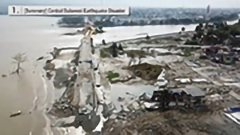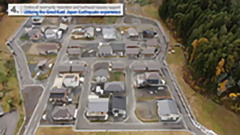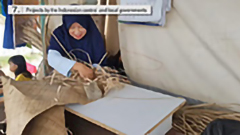JICA's recovery and reconstruction support

The Central Sulawesi earthquake occurred in Indonesia in 2018.
September 28th, 2018, the temblor struck Central Sulawesi Province, Indonesia, and caused massive destruction claiming 4,547 lives, affecting 172,999 people, and destroying about 100,000 homes.
By a request from the Indonesian government, JICA has implemented "The Project for Development of Regional Disaster Risk Resilience Plan in Central Sulawesi" for Palu city, Sigi district and Donggala district from December 2018 till November 2021.
Now, we produced JICA-Net multimedia-based learning material, "Earthquake Recovery and Reconstruction Support for Central Sulawesi, Indonesia: Community Restoration and Livelihood Recovery Initiatives -Applying Japan's Recovery and Reconstruction Experiences to Local Communities-" (Youtube, external link) . Showing the project as an example, the material introduces the experience and knowledge on disaster-resilient community development through the process of community restoration and livelihood recovery efforts. Besides the practice of applying Japanese experience on reconstruction and recovery from the Great East Japan Earthquake to local context in Indonesia to domestic and international.
Reconstruction that supports affected people
In this project, JICA believed that in addition to physical reconstruction, an aim should be to restore the communities divided by disaster. That was based on the experience of reconstruction and recovery in Japan. So, JICA has carried out community restoration and livelihood recovery support.
To achieve this, it was necessary to apply the experiences and learning of Higashimatsushima City, in Miyagi Prefecture and Kamaishi City in Iwate Prefecture, which are the disaster-affected areas of the 2011 Great East Japan Earthquake, to the disaster-affected areas of Central Sulawesi.

Kamaishi's uno sumaicho nebama district aimed to rebuild through relocation to high ground, and local government and residents proactively exchanged opinions.
In the project, Japan's local officials conveyed the experience of recovery and reconstruction in Japan, especially the importance of disaster-resilient community development, continued support to affected people, and building consensus with them in the process of making recovery and relocation plan in Kamaishi and Higashihatsushima.
To recover people's livelihoods and build disaster-resilient communities, it is important for local governments and residents to hold repeating discussions and build consensus.
It is not easy to build consensus with the community. However, this "Slow and Steady" process strengthens the mechanisms of mutual assistance resulting in the development and smooth implementation of various reconstruction project plans without backtracking.
This message reached various people such as local officials in the disaster-affected area of Indonesia, and it brought a change to activities in the local site. For example, in the coastal area that was damaged by a tsunami, local officials asked affected people's requests carefully and built consensus before advancing the relocation plan.
Moreover, at "2nd World Bosai Forum 2019", held in Sendai, Japan, in November, people from Indonesia and Japan involved in recovery and reconstruction gave a joint presentation and shared their experience with the world.
Preparedness for many disasters predicted in future

In Palu city, a group of women who had lost materials and equipment that were the source of their income ore provided support from making and selling handicrafts made of the seller plant as well as for food sales.
Firstly, the material overviews the Central Sulawesi earthquake and JICA's support project. Next, it explains easily how reconstruction and recovery were made in Higashimatsushima and Kamaishi after the Great East Japan Earthquake and how this experience was applied to the disaster-affected areas of Central Sulawesi, taking the example of JICA's support, and activities of local governments and affected people.
We plan to utilize the material for JICA trainees, experts, counterparts, local officials and visitors in Kamaishi and Higashimatushima, for example, in JICA Knowledge Co-Creation Programs performed by JICA Tohoku, the study meeting for international cooperation in Kamaishi City Hall, screening in local site in JICA Partnership Programme by Kamaishi, as the activity information by the general incorporated association, the regional development office in Kamaishi, and Kataribe who tell the experiences and learnings of the disaster to visitors in Higashimatsushima. We estimate more than 100 people in all would view the material in this year.
In addition, we think the material could be used in the Super Science High school (SSH) activity.
Generally, permanent assistance to residents and building consensus are important ways for other technical support in developing countries too. We hope the material could be used widely and be a good reference for various activities.
HIRABAYASHI Atsutoshi
Technical Advisor, JICA Infrastructure Management Department / Secretariat of Japan
Overseas Cooperation Volunteers, Counselor / Community Development Advisor
*The Material(s) mainly applied
Earthquake Recovery and Reconstruction Support for Central Sulawesi, Indonesia: Community Restoration and Livelihood Recovery Initiatives -Applying Japan's Recovery and Reconstruction Experiences to Local Communities-
To Introduce Experience and Knowledge on Disaster-resilient Community Development through the Process of Community Restoration and Livelihood Recovery Efforts and the Practice of Applying Japanese Experience on Reconstruction and Recovery from the Great East Japan Earthquake to Local Context in Indonesia.
Based on the Experience of Reconstruction and Recovery in Japan, To Convey the Importance of Disaster-resilient Community Development and Stand-by Supports to Affected People.




scroll